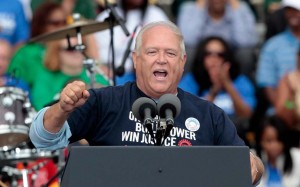United Auto Workers President Dennis Williams renewed his assault on the Trans Pacific Partnership by noting the union now regrets its support for the U.S.-Korea trade pack that was negotiated by the Obama administration.
The TPP is the one of the key items on President Barack Obama’s agenda during his final term in office and enjoys rare support across the political parties as both Democrats and Republicans have spoken out in favor of the proposed agreement, which still needs to be finalized.
Trade pacts, such as TPP, have hurt American workers, he asserted. NAFTA, the trade pact covering Canada, the U.S. and Mexico, has been a disaster for American workers, said Williams, noting the trade pact have left untouched a “corrupt” system that imposes contracts on workers negotiated by state-sponsored unions that never have to answer to their members.
The lax rules have created a situation where not only General Motors, Ford and Fiat Chrysler have moved jobs to Mexico, but also other companies such Toyota, Nissan and Mercedes-Benz as well, he said.
(Ford maintains Trans Pacific Partnership bad deal for automakers. For more, Click Here.)
Williams also said that the Korean Trade Pact signed in 2011, which the UAW supported at the request of Ford and GM, has not worked out as promised. “We’ve lost 75,000 jobs since the pact was signed. It was a mistake,” Williams said during a session with reporters.
Williams’ comments came as Ford announced it was pulling out of the Japanese market and re-iterated its opposition to TPP.
Kevin L. Kearns, president of the U.S. Business and Industry Council, said, “Significant omissions in the Trans-Pacific Partnership, coupled with loosened TPP-area content arrangements, favor Japan’s auto industry.” Kearns believes these are egregious examples of the trade pact’s fatally flawed design.
(Click Here for details about Toyota’s quarterly earnings of $5.4 billion.)
“President Obama should explain why there are 13 side letters in the agreement that specifically address Japan’s auto sector, as well as why it allows parts from China to be incorporated in Japanese autos destined for the US market,” he said.
“The truth is, Tokyo came late to the TPP table, but walked away with significant concessions for its manufacturing industries. The Obama Administration has been taken to the cleaners by Tokyo’s bureaucrat-industry alliance. The same fate befell its predecessors, which is why the Japanese market remains substantially closed after decades of negotiations.”
TPP reduces the already too-low NAFTA parts content standard, thus allowing Toyota and other Japanese automakers to export vehicles to the United States that contain a significant percentage of parts produced in non-TPP countries. Kearns explained, “The major beneficiary of this content-origin loophole is China, which is an important part of Japan’s auto parts supply chain.”
(New Trans-Pacific trade deal faces challenge from U.S. auto industry. For more, Click Here.)
Kearns also pointed to the TPP’s glaring lack of any enforceable provisions to address currency manipulation. Obama’s negotiating team, despite explicit Congressional instructions, opted for a currency “side agreement” that merely restates TPP member countries’ current obligations as members of the International Monetary Fund. The side letter is so meaningless that it is not even going to be signed by the TPP parties. Kearns said, “The omission of enforceable currency provisions alone should render TPP a dead letter for domestic manufacturers — and their representatives in the U.S. Congress.”


Anyone with a clue about business that has read this proposal knows it is a disaster for the U.S, EU and other Western economies. There will be HUGE losses in good jobs in the U.S. if this trade agreement passes. Essentially employment at Wally World or K-Mart will become a “good job” in America when the dust settles. And that’s exactly what the 1% desire. They want a small group of billionaires controlling the minions who have no power or choice. See China now as a picture of what the U.S. could be in 25-35 years.